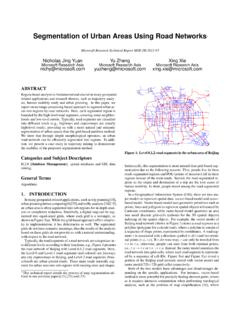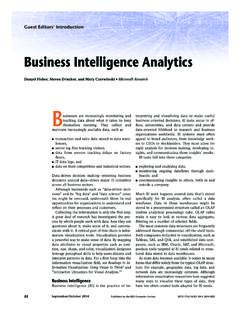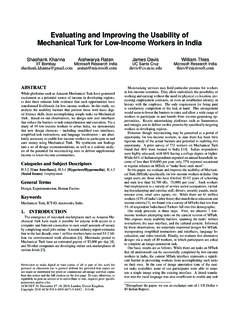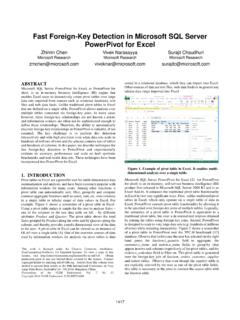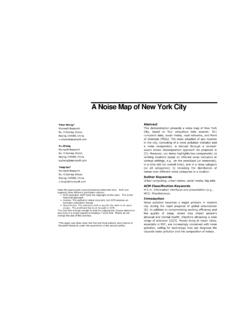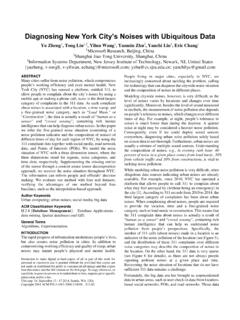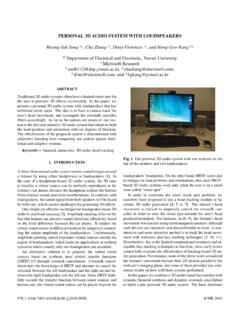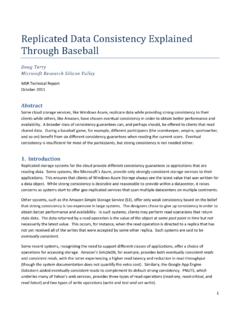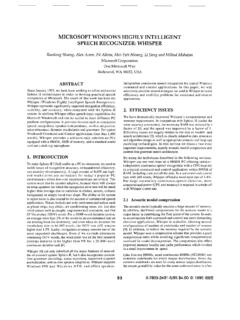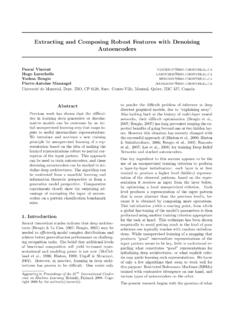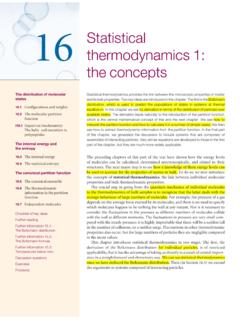Transcription of Learning Deep Structured Semantic Models for Web Search ...
1 Learning Deep Structured Semantic Models for Web Search using Clickthrough Data Po-Sen Huang University of Illinois at Urbana-Champaign 405 N Mathews Ave. Urbana, IL 61801 USA Xiaodong He, Jianfeng Gao, Li Deng, Alex Acero, Larry Heck Microsoft Research, Redmond, WA 98052 USA {xiaohe, jfgao, deng, alexac, ABSTRACT Latent Semantic Models , such as LSA, intend to map a query to its relevant documents at the Semantic level where keyword-based matching often fails. In this study we strive to develop a series of new latent Semantic Models with a deep structure that project queries and documents into a common low-dimensional space where the relevance of a document given a query is readily computed as the distance between them.}
2 The proposed deep Structured Semantic Models are discriminatively trained by maximizing the conditional likelihood of the clicked documents given a query using the clickthrough data. To make our Models applicable to large-scale Web Search applications, we also use a technique called word hashing, which is shown to effectively scale up our Semantic Models to handle large vocabularies which are common in such tasks. The new Models are evaluated on a Web document ranking task using a real-world data set. Results show that our best model significantly outperforms other latent Semantic Models , which were considered state-of-the-art in the performance prior to the work presented in this paper.
3 Categories and Subject Descriptors [Information Storage and Retrieval]: Information Search and Retrieval; [Artificial Intelligence]: Learning General Terms Algorithms, Experimentation Keywords Deep Learning , Semantic Model, Clickthrough Data, Web Search 1. INTRODUCTION Modern Search engines retrieve Web documents mainly by matching keywords in documents with those in Search queries. However, lexical matching can be inaccurate due to the fact that a concept is often expressed using different vocabularies and language styles in documents and queries. Latent Semantic Models such as latent Semantic analysis (LSA) are able to map a query to its relevant documents at the Semantic level where lexical matching often fails ( , [6][15][2][8][21]).
4 These latent Semantic Models address the language discrepancy between Web documents and Search queries by grouping different terms that occur in a similar context into the same Semantic cluster. Thus, a query and a document, represented as two vectors in the lower-dimensional Semantic space, can still have a high similarity score even if they do not share any term. Extending from LSA, probabilistic topic Models such as probabilistic LSA (PLSA) and Latent Dirichlet Allocation (LDA) have also been proposed for Semantic matching [15][2]. However, these Models are often trained in an unsupervised manner using an objective function that is only loosely coupled with the evaluation metric for the retrieval task.
5 Thus the performance of these Models on Web Search tasks is not as good as originally expected. Recently, two lines of research have been conducted to extend the aforementioned latent Semantic Models , which will be briefly reviewed below. First, clickthrough data, which consists of a list of queries and their clicked documents, is exploited for Semantic modeling so as to bridge the language discrepancy between Search queries and Web documents [9][10]. For example, Gao et al. [10] propose the use of Bi-Lingual Topic Models (BLTMs) and linear Discriminative Projection Models (DPMs) for query-document matching at the Semantic level.
6 These Models are trained on clickthrough data using objectives that tailor to the document ranking task. More specifically, BLTM is a generative model that requires that a query and its clicked documents not only share the same distribution over topics but also contain similar factions of words assigned to each topic. In contrast, the DPM is learned using the S2 Net algorithm [26] that follows the pairwise Learning -to-rank paradigm outlined in [3]. After projecting term vectors of queries and documents into concept vectors in a low-dimensional Semantic space, the concept vectors of the query and its clicked documents have a smaller distance than that of the query and its unclicked documents.
7 Gao et al. [10] report that both BLTM and DPM outperform significantly the unsupervised latent Semantic Models , including LSA and PLSA, in the document ranking task. However, the training of BLTM, though using clickthrough data, is to maximize a log-likelihood criterion which is sub-optimal for the evaluation metric for document ranking. On the other hand, the training of DPM involves large-scale matrix multiplications. The sizes of these matrices often grow quickly with the vocabulary size, which could be of an order of millions in Web Search tasks. In order to make the training time tolerable, the vocabulary was pruned aggressively.
8 Although a small vocabulary makes the Models trainable, it leads to suboptimal performance. In the second line of research, Salakhutdinov and Hinton extended the Semantic modeling using deep auto-encoders [22]. Permission to make digital or hard copies of all or part of this work for personal or classroom use is granted without fee provided that copies are not made or distributed for profit or commercial advantage and that copies bear this notice and the full citation on the first page. Copyrights for components of this work owned by others than the author(s) must be honored. Abstracting with credit is permitted.
9 To copy otherwise, or republish, to post on servers or to redistribute to lists, requires prior specific permission and/or a fee. Request permissions from CIKM 13, Oct. 27 Nov. 1, 2013, San Francisco, CA, USA. Copyright is held by the owner/author(s). Publication rights licensed to ACM. ACM 978-1-4503-2263-8/13 $ They demonstrated that hierarchical Semantic structure embedded in the query and the document can be extracted via deep Learning . Superior performance to the conventional LSA is reported [22]. However, the deep Learning approach they used still adopts an unsupervised Learning method where the model parameters are optimized for the reconstruction of the documents rather than for differentiating the relevant documents from the irrelevant ones for a given query.
10 As a result, the deep Learning Models do not significantly outperform the baseline retrieval Models based on keyword matching. Moreover, the Semantic hashing model also faces the scalability challenge regarding large-scale matrix multiplication. We will show in this paper that the capability of Learning Semantic Models with large vocabularies is crucial to obtain good results in real-world Web Search tasks. In this study, extending from both research lines discussed above, we propose a series of Deep Structured Semantic Models (DSSM) for Web Search . More specifically, our best model uses a deep neural network (DNN) to rank a set of documents for a given query as follows.
